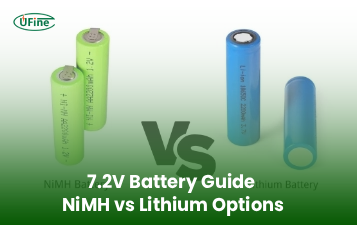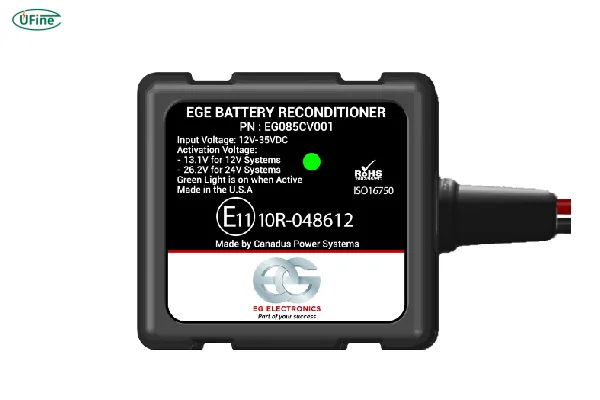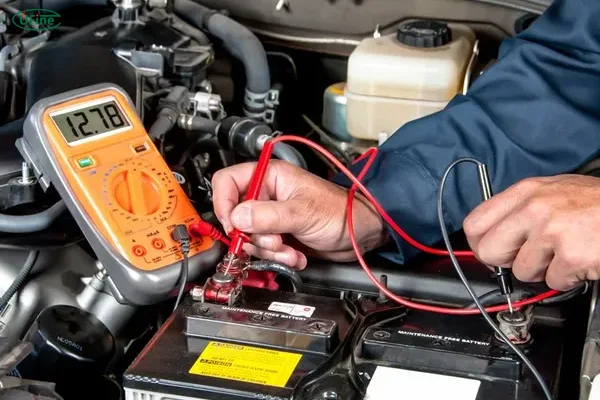
- Part 1. What is a battery reconditioner?
- Part 2. What is battery reconditioning?
- Part 3. Does battery reconditioning really work?
- Part 4. What types of batteries can be reconditioned?
- Part 5. Pros and cons
- Part 6. How to use a battery reconditioner?
- Part 7. How long does reconditioning extend battery life?
- Part 8. Common myths about battery reconditioner
- Part 9. Are battery reconditioners safe to use?
- Part 10. How to choose the right battery reconditioner
- Part 11. Is battery reconditioning worth it?
- Part 12. FAQs
Have you heard of battery reconditioning and wondered if it really works? With rising battery costs and growing e-waste, people are turning to a device called a battery reconditioner to give their old batteries new life. But is it too good to be true?
Let’s explore the truth behind battery reconditioners—how they work, when they’re effective, and what you should know before trying one.
Part 1. What is a battery reconditioner?
A battery reconditioner is a device or tool that helps restore old or weak batteries. It works by reversing sulfation—the buildup of lead sulfate crystals that reduces a battery’s performance.
Most battery reconditioners are smart chargers with a special mode that:
- Sends pulses of high-frequency electricity
- Breaks down lead sulfate buildup
- Revives the battery’s ability to charge and discharge normally
Battery Reconditioning Explained: A Comprehensive Guide
Some reconditioners are built into multi-stage battery chargers. Others are standalone tools focused only on desulfation.
Part 2. What is battery reconditioning?
Battery reconditioning is the process of restoring a battery’s function so it works like new—or at least better. It doesn’t work on every battery, but in many cases, it can help extend battery life significantly.
Here’s how it works, in simple terms:
- Over time, chemical reactions inside the battery cause deposits (like sulfate crystals) to build up on the plates.
- This reduces the battery’s ability to hold and deliver a charge.
- A battery reconditioner “cleans” the plates using electrical pulses.
- The battery regains part or most of its original capacity.
Think of it as cleaning out clogged arteries in a battery’s power flow.
Part 3. Does battery reconditioning really work?
The honest answer: sometimes it works, sometimes it doesn’t.
✅ When it works well:
- The battery is old but not damaged
- The battery just has sulfate buildup (sulfation)
- You use a quality reconditioner properly
- You follow safety and process guidelines
❌ When it doesn’t work:
- The battery is physically damaged or leaking
- The plates are corroded beyond repair
- There are internal short circuits
- It’s a lithium-ion battery with a damaged BMS
In short: battery reconditioning works best on lead-acid batteries and some nickel-based batteries, depending on condition.
Many users have successfully reconditioned car batteries, UPS backup batteries, and even some power tool packs.
Part 4. What types of batteries can be reconditioned?
Not every battery is a good candidate. Here’s a quick breakdown:
| Battery Type | Can It Be Reconditioned? |
|---|---|
| Car (Lead-Acid) | ✅Yes – most common type |
| AGM / Gel Cell | ✅ Yes – with care |
| NiMH / NiCd | ✅ Yes – sometimes |
| Deep-Cycle (RV, solar) | ✅ Yes – very common |
| Lithium-Ion | ⚠️ Rarely – risky or limited |
| Alkaline (AA/AAA) | ❌ No – single-use only |
Lithium-ion batteries, on the other hand, are harder to recondition. Their internal circuits and chemistry are complex. Reconditioning may cause overheating or fire if done incorrectly.
Part 5. Pros and cons
✅ Pros:
- Saves money by extending battery life
- Reduces waste, making it eco-friendly
- Easy to use with the right equipment
- Good for DIYers and mechanics
- Restores backup power in emergencies
❌ Cons:
- Doesn’t work on all batteries
- Results vary—some batteries can’t be saved
- Takes time and patience
- Requires safety precautions
- Risky with lithium batteries
Still, for many people, the pros outweigh the cons—especially if you work with batteries regularly.
Part 6. How to use a battery reconditioner?
The process may differ depending on your battery and the reconditioner model. But here’s a general guide:
🧰 What You Need:
- Battery reconditioner or smart charger with reconditioning mode
- Safety goggles and gloves
- Ventilated space
- Multimeter (optional, for testing)
🔧 Basic Steps:
- Check the battery: Make sure it’s not cracked, swollen, or leaking.
- Clean the terminals: Use baking soda and water to remove corrosion.
- Connect the battery reconditioner: Follow the device’s instructions.
- Select reconditioning mode: Let the device run the full cycle (can take 4–24 hours).
- Test the battery: Use a multimeter or try it in a device to see results.
Some smart chargers will automatically test, recondition, and maintain your battery all in one process.
Part 7. How long does reconditioning extend battery life?
This depends on the battery’s age, chemistry, and condition.
On average:
- Car batteries: Gain 1 to 3 more years
- Deep-cycle batteries: Up to 2 extra years
- NiMH/NiCd batteries: Can regain 70–90% of capacity
Note: Reconditioning may not restore a battery to 100% capacity, but it can still make it usable again.
Some users report reconditioning a battery multiple times over its extended life cycle.
Part 8. Common myths about battery reconditioner
Let’s clear up a few popular myths:
❌ “Battery reconditioning works on every dead battery.”
Not true. Some batteries are too far gone or physically damaged.
❌ “You just need baking soda and vinegar.”
Not enough. Real reconditioning requires electrical desulfation or charging pulses.
❌ “Battery reconditioners are scams.”
Some cheap products may not work, but many real battery reconditioners deliver strong results—if used correctly.
❌ “Lithium-ion batteries can be reconditioned easily.”
Not really. Lithium batteries have safety circuits. Reconditioning them is complex and often unsafe.
Part 9. Are battery reconditioners safe to use?
Yes—if used correctly.
Battery reconditioning is generally safe with proper tools and precautions. Still, you’re dealing with electricity and chemicals, so don’t skip safety steps.
⚠️ Safety Tips:
- Wear gloves and goggles
- Work in a ventilated area
- Never open sealed batteries
- Don’t recondition swollen or leaking batteries
- Follow manufacturer instructions
Also, keep children and pets away from your work area. Even small batteries can be dangerous.
Part 10. How to choose the right battery reconditioner
With many models on the market, here’s what to look for:
✅ Features to Consider:
- Voltage range (12V, 24V, 6V support)
- Desulfation mode or repair mode
- Automatic safety shutoff
- Compatibility with battery types
- Reconditioning cycles (fully automated preferred)
🛠 Recommended Types:
- NOCO Genius series – smart and multi-stage
- CTEK MXS 5.0 – known for reliable reconditioning
- BatteryMINDer – great for long-term battery maintenance
Stick with trusted brands and avoid no-name models with unclear instructions or reviews.
Part 11. Is battery reconditioning worth it?
Yes—for many people, it absolutely is.
You should consider it if:
- You have multiple car or deep-cycle batteries
- You want to save money over time
- You care about reducing battery waste
- You enjoy DIY projects or home repairs
- You rely on backup batteries for off-grid or emergency use
Battery reconditioning isn’t for everyone. But if you use batteries regularly, a battery reconditioner is a smart long-term investment.
Part 12. FAQs
Can I recondition a dead car battery?
Yes—if it’s just sulfated and not damaged. Reconditioning may restore function.
How many times can I recondition a battery?
It varies. Some batteries can be reconditioned 2–5 times before losing capacity completely.
Can I recondition lithium-ion batteries?
Not recommended. Lithium batteries have built-in circuits. Reconditioning them is risky.
How long does the reconditioning process take?
Typically 4 to 24 hours, depending on the battery and the device.
Can I recondition motorcycle or lawn mower batteries?
Yes, if they’re lead-acid. Many users restore small vehicle batteries successfully.
Related Tags:
More Articles

NiMH vs Lithium 7.2V Battery and Charger: Which Is Better?
Compare 7.2V NiMH vs Lithium batteries and chargers in 2025. Learn runtime, weight, charging, lifespan, and cost to choose the best for your device.
How to Choose the Right 7.2V Battery and Charger for Your Device?
Learn how to choose the right 7.2V battery and charger for optimal performance, safety, and longevity across RC, tools, medical, and industrial devices.
Big Square Battery Safety Standards You Must Know
Learn key safety standards for big square batteries to avoid fire risks, shipping delays, and compliance issues in EV, industrial, and energy storage projects.
Big Square Battery Applications in Solar & Industrial Equipment
Big square batteries deliver high capacity, stable output, and long life for solar, industrial, and backup power. Explore key uses and advantages.
Big Square Battery vs Cylindrical Battery: Complete 2025 Guide for EVs, ESS & Industrial Devices
Choosing the right battery is key for designers and engineers. Compare big square vs cylindrical batteries to find the best fit for your application.




